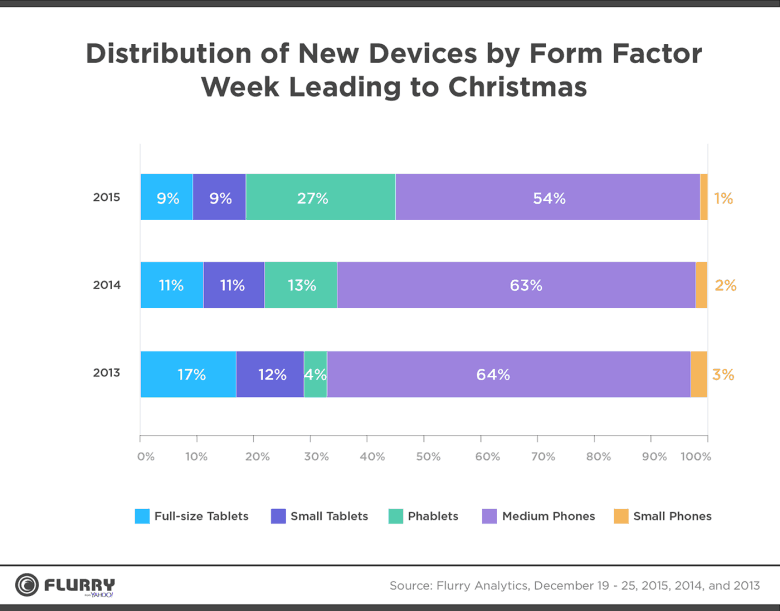It looks like Kris Kringle spent quite a bit of time delivering iPhones and iPads this year. Apple still remains very much in the dominant position for the tech logo people find most under their Christmas trees. The company garnered almost half of the market share — 49.1 percent, to be exact — for device activations this holiday season, far ahead of the usual runner-up, Samsung.
The data comes from Flurry Analytics, which tracks over 780,000 apps and reported about the holiday shopping season for December 19 to December 25.
Even though Samsung continues to lag behind, Apple did lose 2.2 percentage points this year almost exclusively to Samsung, which gained 2.1 percent market share. Flurry attributes this to the launch of the Galaxy Grand Prime, Core Prime and S6 during 2015.

Photo: Flurry Analytics
Meanwhile, Nokia slipped down to 2 percent from 5.8, LG holds 1.7 percent and the Xiaomi now claims the fifth place spot with 1.5 percent. Basically, Apple and Samsung continue to duke it out on top while the rest of the competition fight over the pie crumbs.
Since Flurry has access to so many apps, it was able to reveal a number of other statistics about which devices were most popular for the holidays.
The firm also looked at the various devices we crave, large and small. The form factor that saw the most growth this year is phablets, now with 27 percent market share of tablets and smartphones combined. Just two years ago, phablets only took 4 percent share and last year had 13 percent. Many people once thought that phablets would slowly replace tablet use, but this year they actually grew at the expense of small and medium-sized smartphones. Tablet share only dropped 4 percent cumulatively while medium phones alone lost 9 percent market share for the week leading up to Christmas.

Photo: Flurry Analytics
Of course, once Christmas Day comes along, the first task new users set out to accomplish is to fill up their new devices with apps. Once again, Flurry reports that Christmas Day is the most popular day of the year to download apps. Users downloaded 2.2x more than on the average day throughout the rest of the month.
Judging by the stats from this year, 2016’s holiday wish lists will probably have more phablets on them, even less tablets and likely remain loyal to Apple or Samsung.
Check out Flurry’s report for the full stats on mobile device activations this holiday season.



3 responses to “Apple made up nearly half of all Santa’s mobile presents”
AAPL dropped 1.2% today (12/28), first day of trading after Christmas. I thought maybe analysts had some holiday sales data. Nope, they’re just convinced Apple is heading south and no amount of evidence will convince them otherwise.
The reason is because the iPhone is Apple’s “cash cow”. If it fails (and that’s a huge IF) the company is in serious trouble, by its own standards of today.
Since the iPhone is not the king of innovation and performance as it once was, the market sees a gradual decline. It’s pretty straight forward.
Luckily for Apple, the iPhone still holds it brand value, even if the product itself is not the best out there. But traders wonder how long Apple can hold its brand selling inferior products, at a high premium with the hopes of retaining record profits. That is the concearn. I don’t mean inferior as compared to it’s competition as much as inferior to what Apple customers expect out of the company.
That’s the error most people make. It’s not about performance against its competitors as much as its about performance against itself.
Remember, just because Apple sells tons and tons of devices, doesn’t mean the device is the best iPhone out there. No one would argue that a trillion dollar company like McDonald’s sells quality food. It’s all about the brand. What is the brand worth and what is it’s shelf life if Apple can only provide incremental products. Of course, no one can really say for sure. The brand still seems to have crazy mass appeal.
Despite record profits, and this report about Holiday activations, Apple is in a gradual decline based off its own record. Whereas it’s competitors (with their much lower numbers) are in a gradual up tick based off their own records. It’s not so much about comparing them to eachother, as much as comparing against their own yearly numbers.
What the market is seeing is Apple initially coming out of the gates really strong then eventually fizzing out more year after year. This suggests that the brand may be losing some of its longer term effectiveness. And if the iPhone goes down, Apple (by its own standards) goes down with it. They can forget that new campus.
Compared to a company like Samsung who could lose it’s entire smartphone sector and still do well by its own standards because their product portfolio is so vast.
The way I see it is Apple has three choices. Genuinely improve the iPhone so it can retain its mass appeal or start heavily investing in other product sectors like all its competitors are doing. Or both. Doing “nothing” and just relying on brand will eventually falter. Same is true for any company.
There is no such mobile company as Nokia.